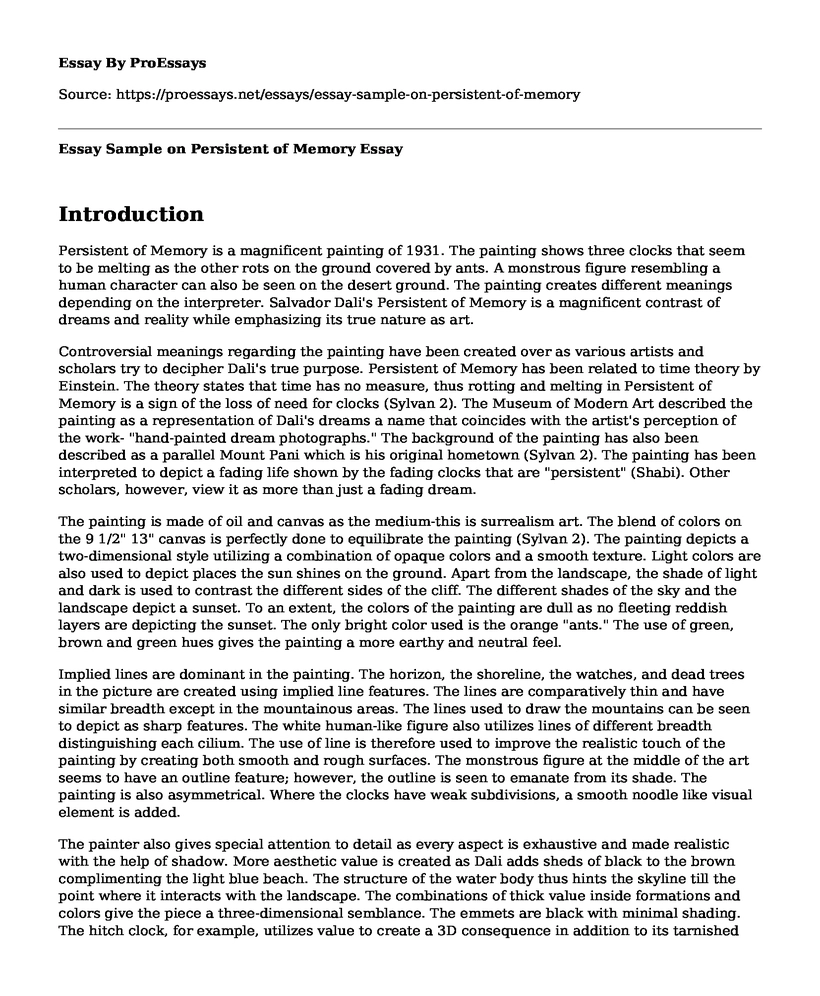Introduction
Persistent of Memory is a magnificent painting of 1931. The painting shows three clocks that seem to be melting as the other rots on the ground covered by ants. A monstrous figure resembling a human character can also be seen on the desert ground. The painting creates different meanings depending on the interpreter. Salvador Dali's Persistent of Memory is a magnificent contrast of dreams and reality while emphasizing its true nature as art.
Controversial meanings regarding the painting have been created over as various artists and scholars try to decipher Dali's true purpose. Persistent of Memory has been related to time theory by Einstein. The theory states that time has no measure, thus rotting and melting in Persistent of Memory is a sign of the loss of need for clocks (Sylvan 2). The Museum of Modern Art described the painting as a representation of Dali's dreams a name that coincides with the artist's perception of the work- "hand-painted dream photographs." The background of the painting has also been described as a parallel Mount Pani which is his original hometown (Sylvan 2). The painting has been interpreted to depict a fading life shown by the fading clocks that are "persistent" (Shabi). Other scholars, however, view it as more than just a fading dream.
The painting is made of oil and canvas as the medium-this is surrealism art. The blend of colors on the 9 1/2" 13" canvas is perfectly done to equilibrate the painting (Sylvan 2). The painting depicts a two-dimensional style utilizing a combination of opaque colors and a smooth texture. Light colors are also used to depict places the sun shines on the ground. Apart from the landscape, the shade of light and dark is used to contrast the different sides of the cliff. The different shades of the sky and the landscape depict a sunset. To an extent, the colors of the painting are dull as no fleeting reddish layers are depicting the sunset. The only bright color used is the orange "ants." The use of green, brown and green hues gives the painting a more earthy and neutral feel.
Implied lines are dominant in the painting. The horizon, the shoreline, the watches, and dead trees in the picture are created using implied line features. The lines are comparatively thin and have similar breadth except in the mountainous areas. The lines used to draw the mountains can be seen to depict as sharp features. The white human-like figure also utilizes lines of different breadth distinguishing each cilium. The use of line is therefore used to improve the realistic touch of the painting by creating both smooth and rough surfaces. The monstrous figure at the middle of the art seems to have an outline feature; however, the outline is seen to emanate from its shade. The painting is also asymmetrical. Where the clocks have weak subdivisions, a smooth noodle like visual element is added.
The painter also gives special attention to detail as every aspect is exhaustive and made realistic with the help of shadow. More aesthetic value is created as Dali adds sheds of black to the brown complimenting the light blue beach. The structure of the water body thus hints the skyline till the point where it interacts with the landscape. The combinations of thick value inside formations and colors give the piece a three-dimensional semblance. The emmets are black with minimal shading. The hitch clock, for example, utilizes value to create a 3D consequence in addition to its tarnished guise as the ticker with emmets draws its presence to the insects on top. Shadowing is also emphasized throughout the mountainous area and points of intersection of features such as the interaction of the water body and landscape. The features on the painting are thus juxtaposed to make specific elements stand out as viewers are drawn the differences and similarities of the representation. The picture, however, lacks a definite motive due to the presence of lone objects in separate pockets and the alterations of scenes from mountains to geometric objects and empty infinite skyline. Motion is mainly seen where the red-stem storksbills create a semblance of dripping metal as the enormous white figure and the water stay still. The ants on the ticker also develop a sense of gesture as they are scattered all over its surface. The painting, therefore, upsets a series of mixed emotions depending on the viewer's perspective.
Conclusion
The exact nature of art is the ability to spark contrasting themes and meanings as per individual interpretation. Dali's Persistent of Memory manages to attain the latter through its coloring, shadowing and values, and overall object representation. The use of a more rich and dark coloring brings the image to life. Shadows are also used to build a clear picture of the beginnings and endings with limited visibility. The contrasting light-dark hues also emphasize the physiques and three-dimensional nature of specific objects in the image. The image therefore has visually striking and controversial features that reject single dimensional rational justification.
References
Barnet, Sylvan. A short guide to writing about art. Pearson Education, 2011.
Shabi K. "Salvador Dali Persistence of Memory: Meaning of the Melting Clocks." LEGOMENON. 30TH April 2013. http://legomenon.com/salvador-Dali-persistence-of-memory-melting-clocks-meaning.html (Accessed 4th December 2018)
Cite this page
Essay Sample on Persistent of Memory. (2022, Oct 17). Retrieved from https://proessays.net/essays/essay-sample-on-persistent-of-memory
If you are the original author of this essay and no longer wish to have it published on the ProEssays website, please click below to request its removal:
- Eras of Western Music - Paper Sample
- Dancing with Beryl - Narrative Essay Sample
- Spending the Night Alone In a Mansion - Essay Sample
- Classical Music Questions and Answers Paper Example
- The Monster in the Hall Play Essay
- Essay Sample on Tamayo's Contradiction: A Revolution in Mexican Art
- Bach's Musical Journey: Exploring Chromatic Fantasies - Essay Sample







